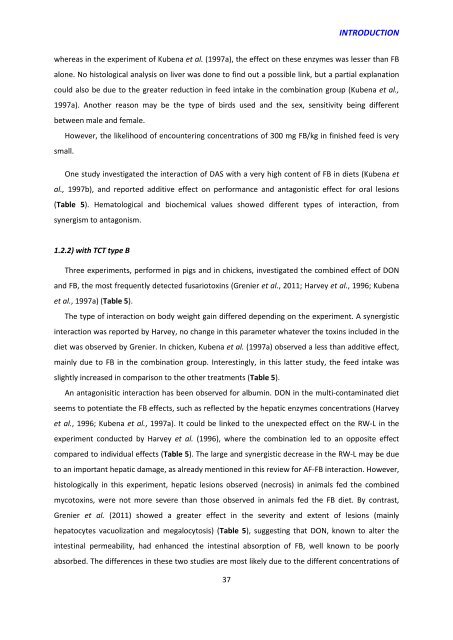Effet chez le porcelet d'une exposition à un régime co-contaminé en ...
Effet chez le porcelet d'une exposition à un régime co-contaminé en ...
Effet chez le porcelet d'une exposition à un régime co-contaminé en ...
You also want an ePaper? Increase the reach of your titles
YUMPU automatically turns print PDFs into web optimized ePapers that Google loves.
INTRODUCTIONwhereas in the experim<strong>en</strong>t of Kub<strong>en</strong>a et al. (1997a), the effect on these <strong>en</strong>zymes was <strong>le</strong>sser than FBalone. No histological analysis on liver was done to find out a possib<strong>le</strong> link, but a partial explanation<strong>co</strong>uld also be due to the greater reduction in feed intake in the <strong>co</strong>mbination group (Kub<strong>en</strong>a et al.,1997a). Another reason may be the type of birds used and the sex, s<strong>en</strong>sitivity being differ<strong>en</strong>tbetwe<strong>en</strong> ma<strong>le</strong> and fema<strong>le</strong>.However, the likelihood of <strong>en</strong><strong>co</strong><strong>un</strong>tering <strong>co</strong>nc<strong>en</strong>trations of 300 mg FB/kg in finished feed is verysmall.One study investigated the interaction of DAS with a very high <strong>co</strong>nt<strong>en</strong>t of FB in diets (Kub<strong>en</strong>a etal., 1997b), and reported additive effect on performance and antagonistic effect for oral <strong>le</strong>sions(Tab<strong>le</strong> 5). Hematological and biochemical values showed differ<strong>en</strong>t types of interaction, fromsynergism to antagonism.1.2.2) with TCT type BThree experim<strong>en</strong>ts, performed in pigs and in chick<strong>en</strong>s, investigated the <strong>co</strong>mbined effect of DONand FB, the most frequ<strong>en</strong>tly detected fusariotoxins (Gr<strong>en</strong>ier et al., 2011; Harvey et al., 1996; Kub<strong>en</strong>aet al., 1997a) (Tab<strong>le</strong> 5).The type of interaction on body weight gain differed dep<strong>en</strong>ding on the experim<strong>en</strong>t. A synergisticinteraction was reported by Harvey, no change in this parameter whatever the toxins included in thediet was observed by Gr<strong>en</strong>ier. In chick<strong>en</strong>, Kub<strong>en</strong>a et al. (1997a) observed a <strong>le</strong>ss than additive effect,mainly due to FB in the <strong>co</strong>mbination group. Interestingly, in this latter study, the feed intake wasslightly increased in <strong>co</strong>mparison to the other treatm<strong>en</strong>ts (Tab<strong>le</strong> 5).An antagonisitic interaction has be<strong>en</strong> observed for albumin. DON in the multi-<strong>co</strong>ntaminated dietseems to pot<strong>en</strong>tiate the FB effects, such as ref<strong>le</strong>cted by the hepatic <strong>en</strong>zymes <strong>co</strong>nc<strong>en</strong>trations (Harveyet al., 1996; Kub<strong>en</strong>a et al., 1997a). It <strong>co</strong>uld be linked to the <strong>un</strong>expected effect on the RW-L in theexperim<strong>en</strong>t <strong>co</strong>nducted by Harvey et al. (1996), where the <strong>co</strong>mbination <strong>le</strong>d to an opposite effect<strong>co</strong>mpared to individual effects (Tab<strong>le</strong> 5). The large and synergistic decrease in the RW-L may be dueto an important hepatic damage, as already m<strong>en</strong>tioned in this review for AF-FB interaction. However,histologically in this experim<strong>en</strong>t, hepatic <strong>le</strong>sions observed (necrosis) in animals fed the <strong>co</strong>mbinedmy<strong>co</strong>toxins, were not more severe than those observed in animals fed the FB diet. By <strong>co</strong>ntrast,Gr<strong>en</strong>ier et al. (2011) showed a greater effect in the severity and ext<strong>en</strong>t of <strong>le</strong>sions (mainlyhepatocytes vacuolization and megalocytosis) (Tab<strong>le</strong> 5), suggesting that DON, known to alter theintestinal permeability, had <strong>en</strong>hanced the intestinal absorption of FB, well known to be poorlyabsorbed. The differ<strong>en</strong>ces in these two studies are most likely due to the differ<strong>en</strong>t <strong>co</strong>nc<strong>en</strong>trations of37

















